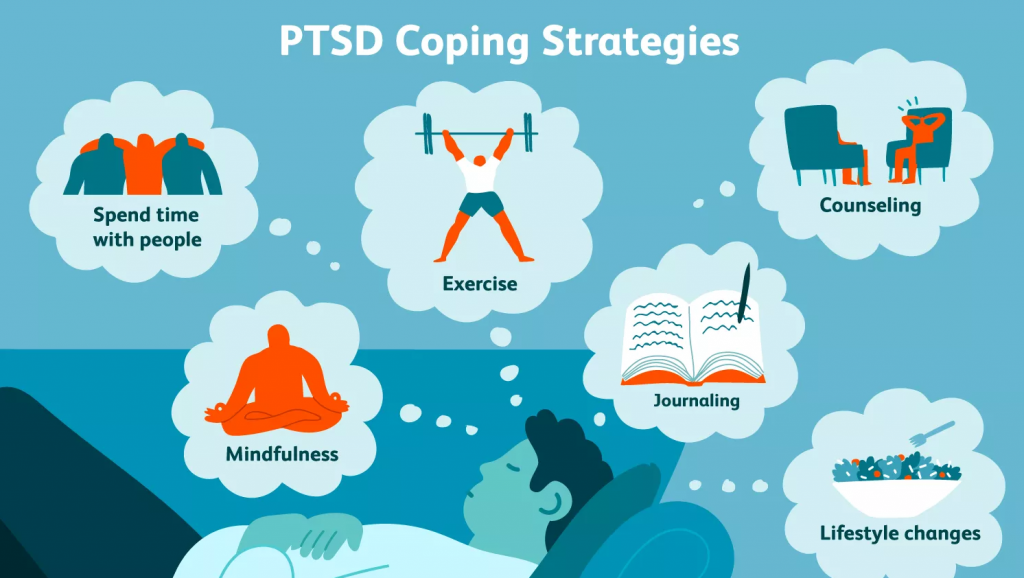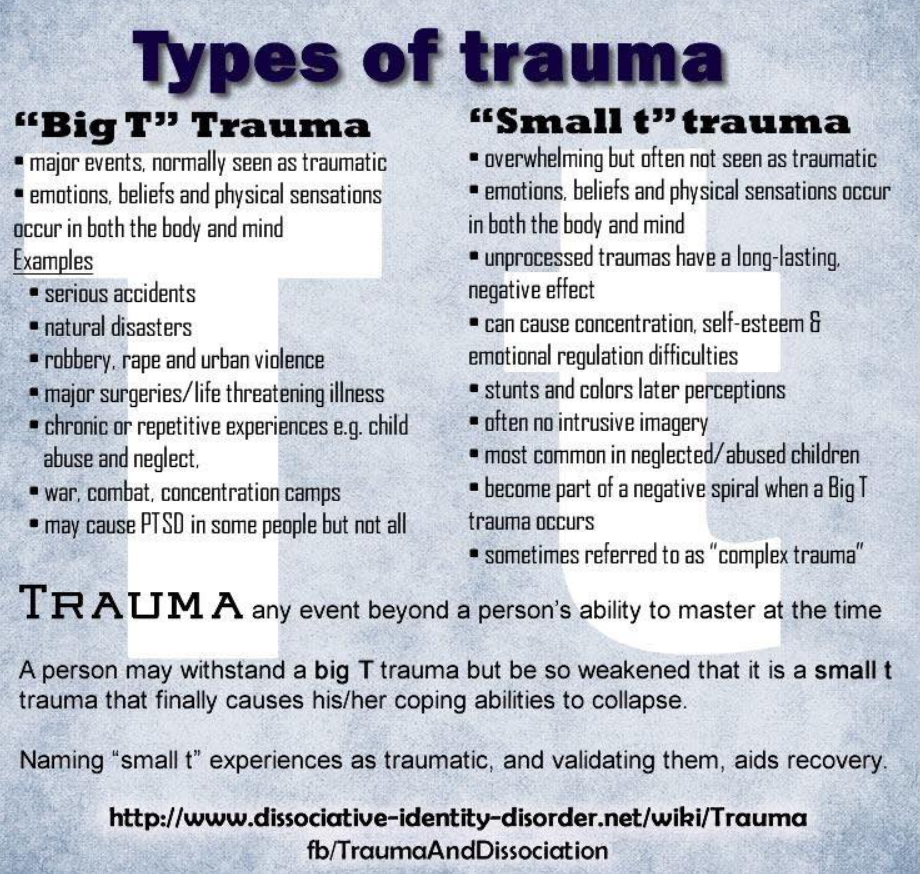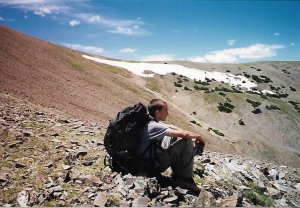In recovery, I’m learning that in the moment many things feel like they are not going well for me. When I look back on each and every one of those events, I now see that each one of them was supposed to happen. They all happened for a reason. Even those really, really bad things that I was ashamed of doing or being apart of, ultimately went well for me.
The events were traumatic experiences, for sure. Anything that is traumatic to me is a “trauma”. I’m learning that we can have “Big T’s” and “Little T’s” in our life. While I might have not had some of the Big T’s of others, like being raped, losing a parent or both at a young age, been abused as a child…it is all relative. When I look at my life, I get to determine which horrific, traumatic experiences are Big or Little Trauma experiences.

It just helps to become real clear. For me to without question understand what life was like and what happened, helps me create a new normal in my life. I must stop the thread or try my best and not carry this on down to my daughter. I have started a list of Big Ts and Little Ts to help wrap my head around them and become crystal clear what happened. I believe that these are the causes and conditions, like pealing the onion, of my need to use substances to escape reality and why I ended up in certain unhealthy relationships.
“Individuals who have experienced trauma are at a much higher risk of developing addiction and substance use disorders, so it is important to understand the overall health implications.
There are two main categories of trauma commonly referred to as Big “T” and little “t.” Big “T” traumas are the events most commonly associated with post-traumatic stress disorder (PTSD) including serious injury, sexual violence, or life-threatening experiences. Threats of serious physical injury, death, or sexual violence can cause intense trauma even if the person is never physically harmed.”
https://journeypureriver.com/big-t-little-t-trauma/
Trauma is an emotional response to a terrible event like an accident, rape or natural disaster. Immediately after the event, shock and denial are typical. Longer term reactions include unpredictable emotions, flashbacks, strained relationships and even physical symptoms like headaches or nausea. While these feelings are normal, some people have difficulty moving on with their lives.
https://www.apa.org/topics/trauma
Anyone who has benefited from keeping a diary or a journal can further justify the time and effort, secure in the knowledge that disclosing innermost thoughts and feelings – even or especially about bad experiences — is good for health. Therapists increasingly encourage patients to undertake writing exercises outside of the clinical setting.
https://www.apa.org/research/action/writing
While large T trauma is more intense and acute, small t trauma can also have a wide range of negative effects on young adults—including depression, anxiety, and other mental health issues.
https://www.newportacademy.com/resources/treatment/adolescent-trauma/
Understanding Little t Trauma
However, what counts as trauma isn’t just an event that’s intense and life endangering. Some types of childhood trauma or adolescent trauma don’t involve violence, death, or disaster, yet they can still have significant negative effects. Any event or ongoing situation that causes distress, fear, and a sense of helplessness may qualify as little t trauma.
For young adults, little t trauma might be the result of a breakup, a challenging friendship, loss of a job, or financial worries. While these incidents don’t threaten the safety of a young person, they may create discomfort, unhappiness, and a feeling of having no control over one’s life. And these feelings can create some of the same symptoms as big T trauma does—although they are usually less severe.
Furthermore, both little t and big T trauma can give rise to mental health conditions such as anxiety and depression. They can also be root causes of co-occurring disorders, such as substance abuse, eating disorders, and other behavioral health issues.

Relational Trauma
Another type of trauma is known as relational trauma, which can manifest during childhood and carry into young adulthood. Relational trauma occurs when a child’s sense of being safe and loved within the family is disrupted. This often occurs as a result of physical or emotional abandonment or neglect. For example, a parent or caregiver may be preoccupied with their own emotional needs, their partner’s needs, or the needs of a sibling. Hence, the child’s emotional—and sometimes physical—needs are not met.
Too much attention from parents to children, without proper boundaries, can also create relational trauma. This is called emotional enmeshment—when a parent/caregiver relies on the child to take care of their emotional needs, or is too involved with a child’s emotional life.
Ultimately, relational trauma, whether as a result of abandonment or enmeshment, can lead to a variety of mental health issues in young adulthood.
How the Brain and Body React to Trauma
Whether it’s little t or big T trauma, the body and brain have a set of specific responses to traumatic experiences. These reactions are the body’s way of protecting us and preparing us to confront a threat.
Experts often refer to these reactions as the “fight or flight” response or the “fight, flight, or freeze” response. However, trauma responses can have additional components as well, often referred to as Fright, Flag, and Faint.
- Freeze: As the brain measures the extent of the threat, the senses heighten in order to expand awareness.
- Flight: The muscles tense in preparation to flee if necessary.
- Fight: Heart rate and respiratory function speed up, preparing the body to confront the danger.
- Fright: Fear takes over in response to a sense of helplessness, reducing the ability to think clearly.
- Flag: The body’s systems begin to shut down, resulting in a numbing of emotions.
- Faint: In extreme cases, the body sometimes responds to trauma by fainting.
The Nervous System and the Effects of Trauma
The reactions listed above, particularly the first three, might be useful or appropriate in acute trauma situations, when an individual is facing a fire, a car accident, or a violent crime, for example. However, the nervous system can’t always distinguish between an actual threat to physical safety and an emotional or mental threat. That’s why little t traumas can have a similar effect on the brain and body as large T traumas.
Moreover, traumatic events and reactions are held as somatic memories in the body. Therefore, even when a traumatic incident or ongoing trauma happened a long time ago, a traumatized brain and body can go into this series of reactions whenever the individual experiences a trauma trigger.
In addition, the nervous system of a trauma survivor can sometimes remain in a state of hyperarousal even when there is no immediate danger. This occurs because the brain and body have not yet found a way to process and let go of trauma.
https://www.newportacademy.com/resources/treatment/adolescent-trauma
Symptoms of Adolescent Trauma
When the nervous system is constantly in fight-flight-freeze mode, mental health and emotional well-being are impacted along with the physical body. Therefore, symptoms of adolescent trauma manifest on multiple levels.
As stated above, the symptoms of small t trauma can resemble those of big T trauma, but are usually less intense. Some common symptoms of adolescent trauma include the following:
- Flashbacks
- Confusion, difficulty focusing, and not being able to make decisions
- Feeling nervous and overwhelmed in everyday situations
- Having a hard time sleeping
- Difficulty enjoying activities that were once pleasurable
- Guilt and shame
- Panic attacks
- Irritability or aggression, sometimes escalating to rage and threats of physical violence
- Nightmares and other night terrors
- A sense of emotional numbness
- Being always on edge
- Depression and grief
- Avoidance: staying away from people, places, or situations that trigger symptoms of trauma
- Suicidal thoughts.
Young Adult Trauma and Co-Occurring Disorders
Young adult trauma, both big T and little t, is a underlying cause of a wide range of mental health conditions, including depression, anxiety, Obsessive Compulsive Disorder, bipolar disorder, personality disorders, and other mood disorders. In addition, adolescent trauma and childhood trauma are often root causes of co-occurring behavioral disorders, such as substance abuse, alcohol abuse, and eating disorders.
Research on these connections reveals the following links between trauma and other mental health disorders:
- There is a strong association between adverse childhood experiences and substance abuse.
- The vast majority of people with anorexia, bulimia, and binge-eating disorder report a history of interpersonal trauma.
- In one study, 48 percent of the adult participants with PTSD had been victims of sexual abuse before the age of 18.
- Childhood trauma in the form of emotional neglect is a significant factor in both depression and bipolar disorder.
Treatment for Big T and Little t Trauma
The most effective treatment for adolescent trauma, whether large T or small t, involves somatic modalities that process trauma through the body, along with cognitive therapy to reframe patterns of thinking around trauma. Approaches include the following:
- Trauma-focused Cognitive Behavioral Therapy to increase coping skills and reframe trauma-related thoughts and beliefs
- Dialectical Behavioral Therapy to increase stress tolerance and emotional regulation skills
- Eye Movement Desensitization and Reprocessing (EMDR) to help the brain release traumatic memories and associations
- Somatic Experiencing or similar types of therapy to process trauma by restoring balance to the nervous system
- The Comprehensive Resource Model, a new approach integrating psychology, spirituality, neurobiology, and somatic techniques
- Experiential modalities to support interpersonal connection, build self-esteem, and allow young people to express emotions nonverbally.
The sooner a young adult receives treatment for the effects of trauma, the more likely they will experience a full recovery. Hence, they can move move confidently and freely into the next stage of life.
Sources:
Eur J Psychotraumatol. 2018; 9(1): 1510279
Int J Eat Disord. 2012 Apr;45(3):307-15.
Depress Anxiety. 2010 Dec; 27(12): 1077–1086.
J Child Sex Abus. 2010 Mar; 19(2): 156–170.
Australian & New Zealand J Psych. 2014; 48(6): 564–570.
